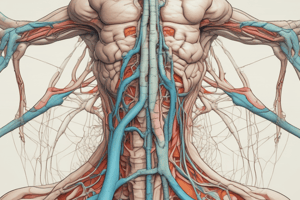Podcast
Questions and Answers
Which of the following is a cause of generalized tissue and organ edema?
Which of the following is a cause of generalized tissue and organ edema?
- Sodium and water retention
- Lymphatic obstruction
- Hyperemia
- Reduced plasma osmotic pressure (correct)
Which protein is the major contributor to plasma osmotic pressure?
Which protein is the major contributor to plasma osmotic pressure?
- Globulin
- Fibrinogen
- Albumin (correct)
- Hemoglobin
Which condition can result in systemic edema due to inadequate levels of circulating protein?
Which condition can result in systemic edema due to inadequate levels of circulating protein?
- Liver failure
- Malnutrition
- Renal failure
- All of the above (correct)
What is the primary cause of lymphatic obstruction?
What is the primary cause of lymphatic obstruction?
What is the term used to describe the passive back-up of blood due to venous obstruction?
What is the term used to describe the passive back-up of blood due to venous obstruction?
What is the consequence of long-standing (chronic) congestion?
What is the consequence of long-standing (chronic) congestion?
What causes an increase in volume of blood in hyperemia?
What causes an increase in volume of blood in hyperemia?
Which of the following is responsible for maintenance of homeostasis in the body?
Which of the following is responsible for maintenance of homeostasis in the body?
Which term refers to an abnormal accumulation of fluid in the interstitial spaces?
Which term refers to an abnormal accumulation of fluid in the interstitial spaces?
What is the main cause of edema resulting from increased hydrostatic pressure?
What is the main cause of edema resulting from increased hydrostatic pressure?
What is the term used to describe an abnormal increase in blood flow to a particular tissue or organ?
What is the term used to describe an abnormal increase in blood flow to a particular tissue or organ?
What is the main difference between acute and chronic passive congestion?
What is the main difference between acute and chronic passive congestion?
What is the term used to describe the escape of blood from the blood vessels into the surrounding tissues?
What is the term used to describe the escape of blood from the blood vessels into the surrounding tissues?
What is the term used to describe a small, pinpoint hemorrhage?
What is the term used to describe a small, pinpoint hemorrhage?
Which of the following is a cause of edema?
Which of the following is a cause of edema?
What is the function of the lymphatic system in relation to edema?
What is the function of the lymphatic system in relation to edema?
What is the relationship between hydrostatic pressure and fluid movement?
What is the relationship between hydrostatic pressure and fluid movement?
What is the consequence of failure in any part of the system that regulates fluid movement?
What is the consequence of failure in any part of the system that regulates fluid movement?
Which condition can lead to localized edema in a limb?
Which condition can lead to localized edema in a limb?
What is the cause of systemic increases in hydrostatic pressure?
What is the cause of systemic increases in hydrostatic pressure?
What is the physiological response to decreased arterial flow to the kidney in cardiac failure?
What is the physiological response to decreased arterial flow to the kidney in cardiac failure?
Which of the following is a characteristic of acute pulmonary congestion?
Which of the following is a characteristic of acute pulmonary congestion?
Which of the following is a unique gross morphology seen in chronic passive congestion of the liver?
Which of the following is a unique gross morphology seen in chronic passive congestion of the liver?
Which of the following is a type of hemorrhage characterized by pinpoint lesions on serosal surfaces and skin?
Which of the following is a type of hemorrhage characterized by pinpoint lesions on serosal surfaces and skin?
What is the size range of purpura lesions?
What is the size range of purpura lesions?
What is the term used to describe larger lesions (larger than 1 cm) that occur in subcutaneous tissues and are commonly called bruises?
What is the term used to describe larger lesions (larger than 1 cm) that occur in subcutaneous tissues and are commonly called bruises?
What is the color sequence of a resolving bruise?
What is the color sequence of a resolving bruise?
What is a large collection of blood that may form in any area of the body called?
What is a large collection of blood that may form in any area of the body called?
What is the clinical significance of a hemorrhage not always directly proportional to?
What is the clinical significance of a hemorrhage not always directly proportional to?
What can a rapid loss of 20% of one's blood volume lead to?
What can a rapid loss of 20% of one's blood volume lead to?
Flashcards are hidden until you start studying




